A tale of the pursuit of one recording, the search for the best pressing, and a few lessons learned along the way. Prepare for a deep dive, and beware of currents.
The story so far…
In the early ’60s, United Artists hired A&R producer guru Alan Douglas to convene some magical artist combinations for their new UA Jazz label, including this unique session by Bill Evans and Jim Hall, graced by one of the most iconic album cover portraits ever: fashion photographer Toni Frissell’s floating model, Weeki Wachee Spring, Florida, for Harpers Magazine (December 1947).
Undercurrent was the subject of an early LJC blog-post five years ago, in 2012, the rip made on an Ion $100 DJ portable. Doesn’t time fly when you’re having fun. (I got to tell you, it also flies when you are not. Bummer). That post raised some concerns about the unsatisfactory engineering/pressing quality of United Artists Jazz original releases.
The sought-after original copy I obtained from the US – described as “near mint” – was troubled with surface noise, not visibly the result of scratches or mishandling. You would grade it as excellent by inspection, it just didn’t play that way, even after multiple RCM washes. More important, the recording didn’t sparkle in the way I had hoped, as a Van Gelder might: the presentation was wooden, lifeless, unengaging. Something wasn’t right.
Controversy Alert!
Both the “Bendy Tenor” United Artists Jazz label and the black label claim (Discogs) “1962” (original) status. United Artists rarely if ever printed a date of copyright or manufacture on label or cover around this time. 1962 is documented as merely the date of recording, so, in the absence of any other information, often assumed by Discogs uploaders to be the date of issue.
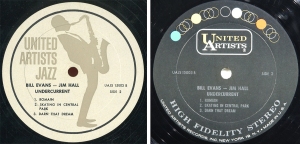 The Bendy Tenor label was in use for only 1962-3-ish during Alan Douglas’s short tenure as producer for United Artists, whilst the black label was a generic United Artists label in use between 1958 and 1968, at the end of which time Transamerica bought United Artists and soon after, Liberty. The black label’s introduction pre-dates the bendy tenor, so it looks “older”, with its arcane “High Fidelity” reference. However I think the black label of Undercurrent is a later second issue, after Alan Douglas departed. As with all these things, little is for certain.
The Bendy Tenor label was in use for only 1962-3-ish during Alan Douglas’s short tenure as producer for United Artists, whilst the black label was a generic United Artists label in use between 1958 and 1968, at the end of which time Transamerica bought United Artists and soon after, Liberty. The black label’s introduction pre-dates the bendy tenor, so it looks “older”, with its arcane “High Fidelity” reference. However I think the black label of Undercurrent is a later second issue, after Alan Douglas departed. As with all these things, little is for certain.
Are “originals” always best for audiophiles?
Whilst with most US recordings the first US original release is the preferred choice, sometimes the original pressing was compromised, by cost-saving shortcuts, sub-standard vinyl, low-cost manufacture. An overseas manufactured release starts out from a copy tape, albeit one generation removed, but the copy tape can be a good transfer, the local engineers can be top-notch technicians not potheads, and the vinyl is pure and not adulterated. British, European and Japanese releases can be a preferred alternative, especially labels like Esquire and Decca. US Riverside, United Artists and Prestige New Jazz are three labels where caution is required.
Undercurrent has seen many reissues over the years, tracing the corporate evolution of United Artists, and its different licensing partners. Discogs lists forty-five different entries for Undercurrent.
 It also appears in a variety of covers, some faithful to the Toni Frissell original, others less so. The posterised Solid State karaoke-art version is simply … dreadful. Perhaps there was a problem with copyright payments. Some covers abandoned the floating woman theme all together, and the Alan Douglas Collection issues (bottom row second left) used many alternative covers.
It also appears in a variety of covers, some faithful to the Toni Frissell original, others less so. The posterised Solid State karaoke-art version is simply … dreadful. Perhaps there was a problem with copyright payments. Some covers abandoned the floating woman theme all together, and the Alan Douglas Collection issues (bottom row second left) used many alternative covers.
Over the following few years, I kept an eye out for other potential releases of Undercurrent, two of which were eventually added to the LJC collection:
T741 World Record Club issue, UK
Alternative cover (air guitar I can understand, but underwater guitar? – chang chang wook wook), unique original liner notes well-written in good English, WRC are usually fairly acceptable, just not this one. Anyone’s guess what’s at fault – poor copy tape, mediocre transfer, budget pressing, but not good.
United Artists Jazz, made in Germany.
Omit the iconic Toni Frissell cover – floating model; flipback cover instead of gatefold; a repeat the corny pulp-fiction liner notes, perhaps they would have read better in German, and format error: mono – this recording demands stereo, that’s my belief, I’m sticking by it. Lacklustre and noisy.
The triumph of hope over experience, both fell considerably short of expectations. Each time I put it any of the three issues on the turntable, play was disappointing. Noisy, and dead, lifeless presentation – to my ear at least. That beautiful cover and beautiful playing was not being matched by beautiful sound, as a result, Undercurrent didn’t get much play.
Then, one day, a chance visit to a record-collecting friend Doctor Who? opened up a fresh perspective. By coincidence it emerged they had the same United Artists “bendy tenor” pressing of Undercurrent. A quick listen confirmed his copy had the same intrusive surface noise, and unsatisfactory audio-quality. So my copy wasn’t an outlier, I guessed they are all like that.
By chance, he was also had a Japanese stereo pressing of Undercurrent, on a very odd “Liberty” label. “Lets give it a go“, I said, opening another bottle. I was quite unprepared for what followed.
Out of the blue, Evans and Hall sprang to life. Up rose the sinuous intertwining of Bill Evans and Jim Hall serpentine figures and luminous, glistening fragments. The presentation was exactly as I knew it should be. You consume every note, you sense the cues and pickups, the telepathic interchange, the sheer artistry and musical intelligence. Engagement! Yess! Excitement! Yess! Undercurrent had finally come home.
Tasting Panel: you be the judge
Bill Evans (piano) Jim Hall (guitar) recorded at Sound Makers, NYC, April 24/ May 14, 1962 engineer Bill Schwartau
1. My Funny Valentine, UAJS 15003 “bendy tenor” release (1962):
![billevanshimhall-undercurrent-labelsbendytenor -1920]](https://londonjazzcollector.files.wordpress.com/2017/05/billevanshimhall-undercurrent-labelsbendytenor-1920.jpg?w=584)
. . .
…
2. My Funny Valentine, EMI-Toshiba LBJ-60051 Japan release (1985):
. . .
Here comes The Judge
 This is my take, you are welcome to form your own opinion, in so far as an mp3 rip via a PC allows. In comparison (on the big system) the Japanese press revealed not only silky-smooth near-silent vinyl (just the odd click), but totally unexpectedly, significantly superior dynamic range. The original displayed a compressed top end, and general lack of life.
This is my take, you are welcome to form your own opinion, in so far as an mp3 rip via a PC allows. In comparison (on the big system) the Japanese press revealed not only silky-smooth near-silent vinyl (just the odd click), but totally unexpectedly, significantly superior dynamic range. The original displayed a compressed top end, and general lack of life.
The Toshiba yielded up a natural, tonally-rich exciting image of Hall and Evan’s instruments in their full glory, which I had not heard in three other pressings. Long standing theories about first pressings being best as “nearest the original recording” were demolished at a stroke. Great thing about actual experience, it trumps theories every time.
The original master tape has to be as near “perfect” as it can be. Why the variation in quality of pressings, especially with the “original”? One can speculate. Perhaps the original mastering engineer tried to fix some perceived problem during mastering, and loused up. Perhaps copy tape sent at the time to Europe also suffered the same problem. Perhaps the copy tape sent to Japan in the ’80s by-passed this problem, or EMI-Toshiba re-mastering was superior to its predecessors. I don’t have an explanation, in many respects it doesn’t really matter why, one sounds better than the other, whatever the explanation.
The listening session and A:B comparison left me with only one problem. I didn’t actually have a copy of the Toshiba, and it looked difficult to source.
Collector’s Corner…some months later…
 It was not until several months passed by that I chanced on a copy of the EMI-Toshiba Liberty pressing for myself, in a London store. I grabbed it in near disbelief. Yes, it was the exact same EMI-Toshiba “Liberty UA Jazz” pressing, and damn the store had priced it up due to it being “excellent” condition. Little did they know of the full story, and my bendy tenor had cost me more than twice as much.
It was not until several months passed by that I chanced on a copy of the EMI-Toshiba Liberty pressing for myself, in a London store. I grabbed it in near disbelief. Yes, it was the exact same EMI-Toshiba “Liberty UA Jazz” pressing, and damn the store had priced it up due to it being “excellent” condition. Little did they know of the full story, and my bendy tenor had cost me more than twice as much.
Once home and mounted on the turntable, the EMI-Toshiba press yielded up the same marvellous experience. It was not a random result from the vagaries of manufacture, it replicated. The search for a perfect copy of Undercurrent, which had taken me down the false trail of originals in nail-biting US auctions and continual frustration, had finally been resolved.
Though Alan Douglas convened some magical artist combinations for UA Jazz, he seemingly had little inkling of what happened in manufacture and engineering, no way he could really, with the equipment in use in the early ’60s. That had to wait for the arrival of today’s modern audiophile rigs, revealing vinyl systems which expose the good and bad engineering, and show that our friends in Japan knew a thing or two about mastering and manufacture. (If any of our Japanese readers would like to take a bow, please, feel free).
Postscript:
A little research revealed that the 1985 EMI-Toshiba Liberty series, which I knew little or nothing of previously, included a whole swathe of Alan Douglas UA Jazz recordings, including quite a few I had found troubled in their original issue. Looks like lots of scope for happy listening here. A warning note however, it’s not all good news. I have the 1985 Toshiba Liberty of two Zoot Sims albums – A Night at the Half Note, and Zoot Sims in Paris, and they are both have a timid and anaemic presentation. There was a weakness in the production chain somewhere. UA may have understood A&R, accounting and marketing but let themselves down on engineering.
Rudy, why didn’t they call you?
The other snippet I discovered was that ten years later, in 1972 according to Billboard, United Artists “purchased the masters of the Alan Douglas collection”. (“Accuracy” was not a strong point in music journalism, then, or now, or indeed any form of journalism.
By the end of the ’60s (not the early ’60s as stated) Transamerica Corp. had purchased control of both Liberty and United Artists, and thereby the Blue Note assets. The Douglas masters were produced in 1962 for United Artists Jazz label. Solid State was created four years later around 1966. Just about every statement in that tiny paragraph is incorrect, apart from the fact UA purchased the Alan Douglas masters for themselves in 1972. Douglas was a wily old bird, he probably retained the rights to those recordings himself, even though he produced them for UA.
What is the story behind the variable quality of original releases of Douglas’s Jazz series? Money Jungle sounds ropey, as does Three Blind Mice, and A Night at The Half Note. Too many questions, not enough answers. Enough for one post!
Thoughts on anything in today’s keyboard punishment welcome, as always. Do you have any of the Douglas UA series? What do you think of them? Am I the only one here who has an issue? Help!
LJC

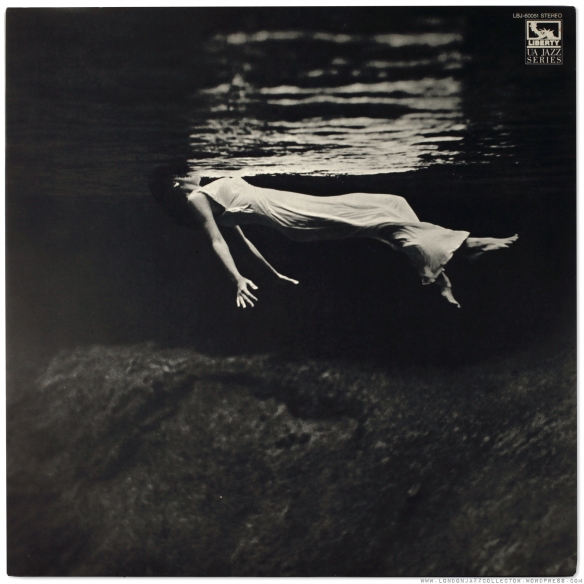



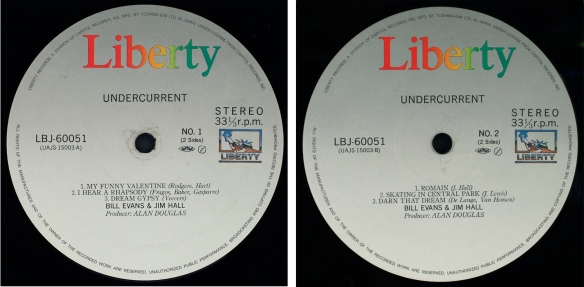
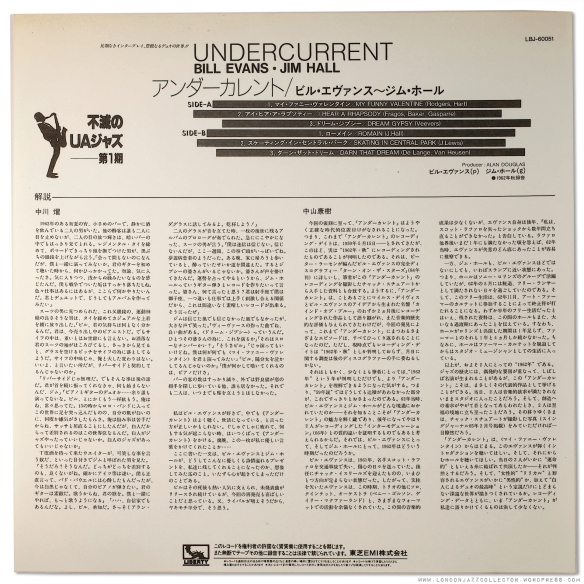
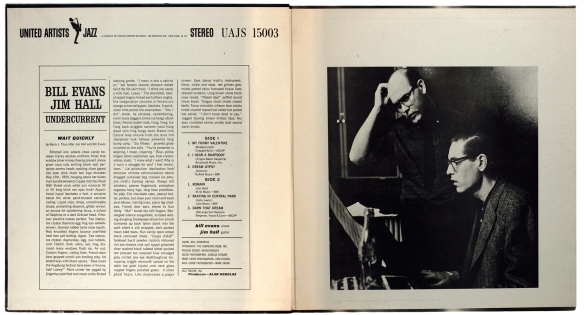



Thank you for the comparison. Would you please comment, is the first (original) rip taken from the same copy you had bought in 2012? Because I’ve listened to the rip you’ve made in 2012 and it sounded way much better.
And comparing these two I have to say that both original and japanese version you’ve ripped share the same problems, just a little less distortions of the loud sounds and overall cleaner surface.
LikeLike
Interesting comments. The 2012 rip was made on a $100 ION USB Turntable with line input to the computer, inaccurate rotational speed, and the resulting MP3 file quite low resolution.180kbps. There is probably a good match between its lo-fi specification and PC audio, and sound better than they should.
The update was 2017, direct output from the big hi-fi system. through a DAC to laptop running Audacity for higher resolution MP3 320kbps file. I also now use an ultrasonic record cleaner . There are so many differences in the source between the two, I am not sure that they offer a fair comparison between the records, but I don’t have the inclination the re-rip the audio samples on a thousand plus posts. I’ll maybe have a A/B listening update for Undercurrent. Many of my records sound quite different since I replaced my solid state power amp with valves. Most sound much better but a few sound worse.
I noticed from comments over the years that people have different fault tolerances. I don’t mind a bit of distortion from a hot recording, hardly notice groove-wear, but find it hard to listen to surface noise, especially from recycled vinyl, and dirty factory pressings with many random clicks.
LikeLike
I just encountered a 85 toshiba pressing of undercurrent and it is really quiet with dynamic sound. So any thoughts for the better pressing of 3 blind mice? I love this recording so much and I would like to know if any opinions on this 76 Japanese reissues LAX3114.
https://www.discogs.com/Art-Blakey-The-Jazz-Messengers-3-Blind-Mice/release/4527384
LikeLike
My orig. stereo pressing is pretty lifeless too. I was disappointed though I paid very little for it so it wasn’t a financial hit. The musoc is great so now I guess I have to find a Toshib pressing.
LikeLike
Anyone has had a chance to listen to the tan label “The Douglas Collection” series?
https://www.discogs.com/Bill-Evans-Jim-Hall-Undercurrent/release/1656665
LikeLike
LJC, thank you for your post – it was very interesting for me because there is one of my favorite recordings from Bill Evans. But I also have a question about another Japanese release of this album – https://www.discogs.com/Bill-Evans-Jim-Hall-Undercurrent/release/9815305 . Does anybody compare this one with another releases? I have it and from my point of view it sounds good, very good, without any noise, but my audio equipment not so good.
LikeLike
Nippon Columbia were a good manufacturer. Though I haven’t heard this specific record, I have others manufactured by Nippon Columbia and they are fine clean pressings. But as always, everything depends on the quality of the tape transfer they were sent. For example My Victor/Riversides are very poor transfers, the blame points to the source.
LikeLike
“For example My Victor/Riversides… ” – do you mean first japanese pressing (stereo serie “SR-xxxx” and mono serie “R-xxxx”)?
LikeLike
Late ’70s early ’80s pressings, reissues with facsimile labels, cover and liner notes, but lousy sonics, rolled off top end and weak bass.
LikeLike
Clear! You mean series SMJ, VIJ, TIJJ etc. I don’t buy it. I buy only japanese first pressing (as I told SR and R series) and second pressing (looks funny but it was pressing on Fontana labels). From my point of view it sounds very good.
LikeLike
I can’t even remember how many records I bought that looked perfect but played with background crackling. I used to think that the grooves were compromised from dull needles or from being played on those once popular ‘suitcase’ record players. I never imagined that the masters were at fault.
A big problem with auction sites is that high volume sellers rarely play-grade anything. I have records with scuffs that sound wonderful and others that look perfect that sound terrible. I have a few European pressings of classical music with background noise that I managed to remedy with a small adjustment to the vertical tracking angle. If the master tapes were the cause, I guess that a complete re-mastering would be needed.
LikeLike
In this discussion of Undercurrent – and reissues of it – I’m surprised no mention of the MFSL release from a few years back. I have that one. I think the only issues I hear are limitations of the master….otherwise a fairly good sounding recording (and the pressing surely gets out of the way)
LikeLike
Interesting. What more can you tell us about MFSL – I’ve not heard one. Any idea what source they use? When were they manufactured? Engineer? Have you A:B’d any against same recording original? Or against other modern reissues? A sample of one is what it is, if you are happy with it, that’s fine. I like to make comparisons, sometimes with surprising results.
LikeLike
MFSL’s release of Undercurrent was part of their “Silver Label” series. This means it was pressed on standard-weight vinyl (by RTI) and was not mastered from analog master tapes but the “best” available source. Here’s a little more info:
https://www.musicdirect.com/vinyl/bill-evans-and-jim-hall-undercurrent-numbered-limited-edition-vinyl-lp
LikeLike
So sorry for taking so long to reply – I will do some AB’s with my buddies. I bet we’ve got a 1/2 dozen between the few of us, here locally.
LikeLike
I have an opportunity to grab the blue label king press….
I have a late 80’s press….so flat sounds like they both used the same mic…
Will let you …
LikeLike
Know how it goes
LikeLike
Thank you very much for another informative post. I have checked my UA records after I cleaned them.
My copies of Undercurrent (stereo without P), Matador (stereo with P), Money Jungle (mono with P), and Zoot Sims in Paris (stereo Bell Sound) are all OK. Something Tender by Bud Freeman (mono without P) has a continuous noise like a recyled vinyl. When I use headphones, I feel uncomfortable because it is a quieter session of a tenor sax plus two guitars.
All these five LPs are bendy tenor labels without DG.
Jazz Portraits (UAL 4036), the original of Mingus Wonderland, is second UA label with DG, the sound is nice.
I can say some bendy tenors have sound problems, in my case without P but others with P.
“Originals” are not always best for audiophiles, this is a great lesson for me.
LikeLike
Seems like that the copys with ear has most problems. Maybe plastylite fucked up on this one because my friends copy with ear are noise. Both are the bendy tenor label
LikeLike
Mine copy has no ear. Both are monos
LikeLike
my copy has no ears, bendy tenor labels without grooves. The copy is mono and the sound is excellent.
LikeLike
Problem solved:)
LikeLike
My ““bendy tenor” mono copy sounds sweet, no distortion.
LikeLike
No ear on this one. Dated 62 inside gatefold by previous owner
LikeLike
Same thing, I have the Bendy… I love the cover, gate fold and artwork etc, the music, i have always really wanted to enjoy it but the noise puts me off. I have a Jerome Richardson “Going to the Movies” which sounds great on the Bendy Tenorman label. If you find a copy check the ‘No Problem’ track…it’s incredible! https://www.youtube.com/watch?v=pdBk6xe7ohs
LikeLike
I have the black label issue with deep groove and Plastylite ear and had mostly the same listening experience. The dulness of the sound I can stand but the constant surface hiss, though quite low, is total murder on such a quiet, delicate session. Normally I’m in the same boat as Gregory – I like to have original pressings and don’t much mind if the sound isn’t quite up to par due to wear or bad mastering – but this is a bit too much even for me so I think I’ll seek out a Japanese pressing eventually. Might pair it with my US cover though for the best of both worlds as I love the textured, heavy cardstock on it; humble, somewhat flimsy Japanese covers never compare.
LikeLike
enough to turn away a fellow 1st press devotee? man, i need to find an original of this just to hear what this is all about! i can’t hear too much distinction in the two clips, being mp3s and such.
LikeLike
Gregory, they sounded night and day different on my HifiMan ‘phones.
What the heck were you listening to the clips with?
LikeLike
Listening through speakers, they sounded very similar, but I decided to also give a listen on headphones and could hear a small amount of distortion on the loudest plucks of the guitar with the original. I find that headphones often magnify details and as a result have the potential to magnify the imperfections in a pressing/recording.
LikeLike
Hi Andrew
Fascinating write up on this album which is one I don’t have yet in any format. Just thought I’d give you a word of warning on WRC LPs which I have quite a number of and I see you have this title on a Stereo WRC, they are usually always very acceptable in Mono but on all the US recorded titles I’ve come across the Stereo sounds like the fake “electronically enhanced for stereo” although this is never stated on the cover, no idea why. I always avoid them. The uk recorded stereos are fine though I have the Tubby Hayes also Zoot Sims & Al Cohn in London. I wonder if anyone else has found this?
LikeLike
My WRC roster includes: Bill Evans Undercurrent (S), Gil Evans Into The Hot (S), Stan Getz The Steamer (M), Paul Gonsalves Sitting In (M), Tubby Change Of Setting (S), Philly Joe Vamp Till Ready (M), Mingus Jazz Portraits (Wonderland) (M)
I really must sit down and do a horizontal and vertical comparison when I have time. Quite a few have a comparator on the shelf. I was never able to deduce who pressed them, possibly Oriole, who did a lot of jobbing pressing.
I feel a future post coming on.
LikeLike
Hi i have the bendy tenor mono UAJ 14003 and my father had written december 62 inside the gatefold. Sounds okay apart from a bit of noise at the beginning of My Funny Valentine.
LikeLike
time for some research – all of of my bendy tenor copies the following have the P: 3 blind mice, money jungle, undercurrent, wonderland. not all are are DG, however. only the evans and mingus are DG. interestingly, the other ua black label pressings are all dg, including west coast vibes and i want to live (actually a red label). i’m guessing different press plants? thoughts?
LikeLike
one other observation: the dg are all stereo the mono are non-dg
LikeLike
I have Money Jungle, Town Hall, 3 Blind Mice, and Birdcall, all on bendy tenor labels, as they are the original for that little run. The Wonderland is a repress if I recall correctly, though I can’t remember of what. I really want the McIntyre and McGhee, but they are absurdly rare, and there’s virtually no chance. I would pick up some others, including Undercurrent, but I am not actively searching at the moment.
In any case, I like this post, because it reveals interesting differences in the way people collect. I collect strictly 1st pressings, purely because I find it more fun. That’s my whole motivation. I am not an audiophile, so I don’t mind if a later issue is sonically superior. It’s fun to have the true original. It feels historically significant. I like that others collect differently for other reasons. And I like reading about it.
LikeLike
I think it’s just a repress of Jazz Portraits, released a little earlier by UA
LikeLike
that’s it, yes. i couldn’t remember, but this is correct.
LikeLike
There are like three copies of Year of the Iron Sheep sitting in the bins at the Jazz Record Center. Or at least there were before WFMU…
LikeLike
he also had the McGhee but it was in rough shape.
LikeLike
I haven’t been there is awhile. I never get to NYC any more, but when I do I always check. Too bad I haven’t gotten in there, I’d love to buy one of those!
LikeLike
My stereo copy is a bendy tenor. No ear. In my opinion, the intrinsic sound quality is very dynamic and alive. This is why I’m puzzled to hear multiple other bendy tenor copies sound “flat”. However, my copy has some big problems: 1) there is distortion at high volume peaks, especially with loud attacks in piano and guitar. This comes up intermittently here and there, and not on all tracks. 2) At the beginning of side 2, there is horrible, horrible distortion, as if someone scratched out a few revolutions of groove with an ice pick. Lasts about 10 seconds, and then it’s gone for good. I’m not quite sure what to make of my copy overall, total mixed bag.
What’s going on with these pressings???!!!
LikeLike
forgot to mention that I’ve read online that the master tape has lots of distortion. LJC, your Toshiba pressing seems to refute this notion.
LikeLike
I just encountered a 85 toshiba pressing of undercurrent and it is really quiet with dynamic sound. So any thoughts for the better pressing of 3 blind mice? I love this recording so much and I would like to know if any opinions on this 76 Japanese reissues LAX3114.
https://www.discogs.com/Art-Blakey-The-Jazz-Messengers-3-Blind-Mice/release/4527384
LikeLike
Off topic, LJC, but that one day/year has come-the day we should all get down on our knees and give thanks to one special individual:
http://www.jazzspeaks.org/the-jazz-gallery-honors-gala-michael-cuscuna/
LikeLike
LikeLike
Thanks for ruining my day LJC. Pulled out my Bendy Tenor DG Stereo copy and it is noisy as heck. It looks perfect and had been thoroughly cleaned. Sounds like some of Bob Weinstock’s special edition New Jazz “purple haze” vinyl was sourced for this record too.
LikeLike
Not sure if it’s just my computer/browser/whatever, but I couldn’t play version 1 (bendy tenor). V2 (Japan) played fine…
LikeLike
There was a problem, I’ve now fixed it, apologies, all runs smoothly now.
LikeLike
LJC, the link to your 5 year old post doesn’t work (and I was looking forward to reading it)
LikeLike
Hi, I’ll fix it. In the meantime, it’s here
LikeLike
I’m unable to compare both versions, the first isn’t working. I’m listening to the original mono right now. maybe I’m accustomed to the original sound (it’s a record I bought in the 70’s), but I don’t like the sound of the Jap copy (which I owned in the past). ok, I’m listening on my gear that’s good enough but I prefer my UA sax copy, ear on both sides,1A both sides and this is my best loved cover of all. background is silent, most of the music is in the middle range, no bass, no drums. I loved this record when I bought it, I still love it the same after 40 years at least.
LikeLike
Is that Lucky Thompson on the label?
I had the “bendy tenor” issue of this and sold it. Indeed, the pressing was problematic, and I’d happily take a copy of the Toshiba as a replacement.
LikeLike
Glad you dug into this topic. I’ve always been mystified about how this record can look so good and sound so bad. I obtained a pristine “bendy tenor” many years ago and recall being instantly struck by intolerable surface noise. So I picked up a second “bendy tenor” several years ago, and same problem. Recently I ran both through an ultrasonic record cleaner without improvement (of course). No other Alan Douglas releases in my collection. So now the hunt begins for a Toshiba copy of Undercurrent.
LikeLike
Btw, neither of my stereo bendy copies has the ear. Makes one wonder if UA went to Plastylite because the first pressing was faulty, or Plastylite was used from the beginning.
LikeLike
Curious if there is a difference between the original US versions depending on pressing plant. This was one where some originals have the Plastylite ear and others don’t and were presumably pressed somewhere else.
LikeLike
FYI mine (Black label) has Plastylite ear on both sides, handwritten matrix, suffix -1A on both sides. I once had other copies (including “bendy tenor”) but I don’t remember if they had Plastylite ear, nor matrix inscription info.
LikeLike
I’ve only owned bendy tenor copies, a Stereo and a Mono, one was Plastylite and the other was not. Not recalling at the moment which was which.
LikeLike
My two cents: black label is the first. I guess so because all the black label UAJ copies I’ve seen are only some early releases so far (“Undercurrent” and “Three Blind Mice”). Not sure if it’s a correct guess or not, though.
LikeLike